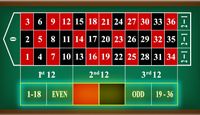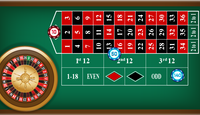1. The Martingale Strategy
The Martingale system is the most popular and commonly used strategy in online Roulette. This strategy is pretty simple. You double your bets after every loss, so when you eventually win, you get your lost money back. After you win, you start betting with your start amount.
The most effective way to use the Martingale system is to only bet on even-money outside bets – 1-18, 19-36, Red, Black, Even, and Odd. The outside bets in Roulette have almost 50% chance of winning, but they offer the lowest payout of all – 1:1. This means that you win the same amount of money you bet for the spin.
The Martingale system seems quite logical and fairly simple to implement. However, many seasoned players don’t like it very much. The Martingale is rather risky, and you’re essentially betting big to win small. And there is a risk of losing a huge amount of money while using this system. Double your bet everytime you lose, can go very fast and you'll soon be wagering a huge amount of money.
10-20-40-80-160-320-640-1280-2560-5120-10040 and so on
2. d'Alembert Strategy
Like the Martingale system, the D’Alembert system is based on bets placed on even-money areas of the table. However, instead of doubling the stake after a losing bet, as in the Martingale, one unit is added to the player’s stake. After a win, the stake decreases by one unit.
Let’s assume you place a base unit stake of £1. If the bet loses, the next wager is £2. If that loses, the next bet becomes £3, and so on. If you manage to win the £3 bet, your following bet will drop to £2.
One of the biggest advantages of this system is that it keeps a handle on your streaks, at least in the short term. You’re not doubling your wager after each loss, as in the Martingale, and things do even out if you win as many spins as you lose.
3. The James Bond Strategy
The James Bond Roulette Strategy is a betting system used to turn the odds of the roulette wheel in your favor. Like most other strategies the Bond Roulette Strategy uses the Martingale Strategy as its foundation. The goal is to cover as much of the roulette wheel as possible. We are going to take a $200 bet and show you how to distribute it when wagering the Bond way.
You will bet $140 on high numbers (19 – 36), this makes up for 70% of your total bet.
Bet $50 on the lower numbers (13 – 18), this makes up 25% of your bet.
Bet $10 on the zero, this makes up the final 5% of your total bet.
Using this James Bond Roulette Strategy will ensure you that if a high number comes out (19 – 36), your profit will be equal to $80. If a lower number comes out (13 – 18), you can expect a profit of $100 and if you get a zero, then your profit will be $160. It is important to note that no betting system or strategy you use will guarantee a win. In games of chance, there is that element of chance and luck that always plays a big role. When using this roulette strategy, there is always the chance that it will land on a number between 1 and 12 and you will lose.Typically, the James Bond Roulette Strategy is a flat betting system, however many players have then combined it with the Martingale System and made it a combination strategy. When losing, you would then use the Martingale progression strategy and double your bets the next round you play.
It is important that gamblers always set themselves a limit when gambling. Make sure you know what this limit is and stick to it. Gambling is meant to be fun and enjoyable and if you practice responsible gambling, it will not cause you any stress personally or financially.
4. The Paroli Strategy
If you’re a big believer in a hot winning streak and playing your rushes, then the Paroli system might be for you. The basic idea is that if you lose, you maintain the same bet as always. If you win, however, you double your stake for the next spin.
You don’t do this indefinitely, obviously. The hope is to win three spins in a row, at which point you’ll revert back to the original stake.
When it works, the Paroli system can give you some medium-sized wins while limiting your losses to much smaller amounts. However, you’re never going to truly smash the casino with this strategy, as the best possible outcome is winning seven units after three spins — hardly earth-shattering money.
If you’re losing, though, the Paroli system isn’t likely to dig you out of the hole very quickly. Most days, the Paroli system will just ensure you lose money very slowly.
Another issue with it is that it can be difficult to keep track of when you’re in the hustle and bustle of the pit. Was that three wins in a row, or just two? If you can’t track things like that reliably, it can defeat the whole purpose of the strategy.
5. The Labouchere Strategy
While all of the roulette strategies so far have been fairly straightforward, the Labouchere system is a bit more complex. It involves deciding how much you’d like to win for the day — let’s say $10 — and dividing that number into smaller, random numbers. So, you’d turn the 10 into 4, 1, 2, 1, 2. You’d then combine two of the numbers — let’s say 4 and 1 — and that would be your first wager: $5. Place that amount on one of the nearly even-money bets (red, black, odd, even, 1-18, or 19-36). If you win, you’ll cross off the numbers you used to wager. If you lose, you have to add the amount you just wagered ($5) to the right of your sequence. The idea is to play until you’ve crossed off all your numbers. It should be immediately obvious what the downsides of the Labouchere system are. It can be incredibly complex for one thing (and you don’t want to be the nerd with a pen and pad at the roulette table). Also, if you lose, that string of numbers could get really long, and you may never clear it. It’s a lot of work to chase a small amount of money. Also, it’s not really as fun as some of these other roulette strategies (unless you really love math).
6. The Andrucci Strategy
This one’s less of a “system” and more just organized chaos. It relies heavily on gut feelings and using past occurrences to predict future events. Other than that, though, it’s solid! The idea of the Andrucci system is that you’ll head over to the table and bet on one of the relatively even-money wagers for a while. How long? About 30-37 times, to be exact. However, during this time, you’re not just gambling — you’re watching. And taking notes. Specifically, you’re looking to see if there are any numbers that the wheel “likes” that day. Once you’re done with your even-money betting, you’ll switch to making single bets on any number that seems hot to you. The thinking is that you can capitalize on those hot numbers for some massive payouts. And yes, you can hit some massive winners with this strategy — after all, the payout for a single number hitting is 35 to 1. The only problem with that is your odds of hitting a single number are 37 to 1, so unless you’re actually capable of predicting the future, you’re going to go broke pretty quickly. It also requires quite a bit of legwork before you can put it into practice. It could take at least an hour just to figure out which numbers are hot, and if the wheel doesn’t cooperate, you may never figure it out. Strategies like this can be enticing to newer players because when you hit one of those single number bets, you will make a ton of money. Raking in all that cash in one fell swoop just makes you feel like you’re winning, and you don’t notice how you’re slowly bleeding out more than that on every other spin of the wheel. Of course, that fallacious thinking is the entire reason why Vegas exists.
If you’re familiar with the idea behind the Fibonacci sequence, then you’re already halfway to understanding this strategy. A Fibonacci sequence is a series of numbers in which the next digit is the sum of the two preceding ones. The most common is this: 0, 1, 1, 2, 3, 5, and so on. How would you use this at the roulette table? Simple — every time you lose, you move to the next number of the sequence, and every time you win, you move back two spots. Sorry — did we say that was simple? It’s actually fairly complex, especially if you’re trying to do the math while following the action at the roulette table. The bets must only be placed on the even-money spots of the wheel, which we suppose is a small bit of mercy. All math jokes aside, this is actually one of the more stable betting strategies you can follow. Losses won’t be as gigantic as they can be with the Martingale system, and it’s not based on a gut feeling like the Andrucci system. Of course, you won’t win much either, and some days you’ll still have to suffer a pretty considerable setback. If your goal is to just spend more time at the table, though, you could do a lot worse.
8. Constant bet Strategy
Forgive us if you've heard this one before. Or maybe not. As that's the whole point of the constant bet strategy, after all, that is making the same wager over and over and over again at the roulette table. It's a simplistic approach, more so than some of the other strategies you'll read in this article. It's so simple, in fact, that a lot of players use it without already knowing. Some casino players even hesitate to call it a 'roulette strategy.' However, we disagree. Everyone has their ways of playing the roulette game, and this is just as valid as any other system out there. The way this strategy works varies dramatically depending on your own personal bankroll and the types of bets you place. It's not exactly optimal for those of you with low bankrolls who like to bet big, for example.
Good Luck
with finding the right game and the right strategy








